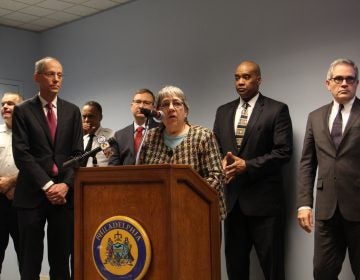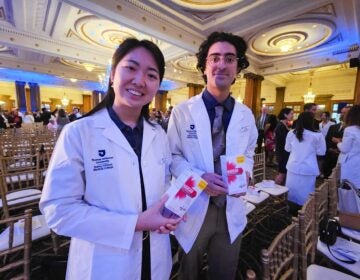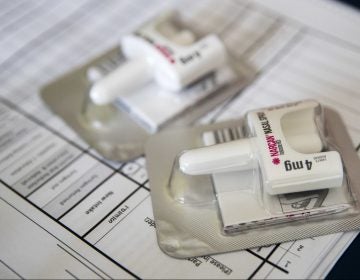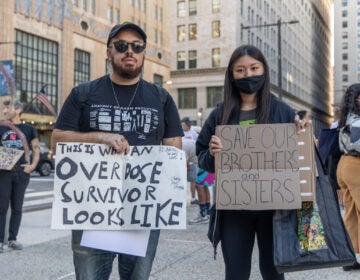Talk of Philly safe-injection site heats up at community meeting
A heated meeting on Friday night showed that turning the idea of Philadelphia opening the country's first safe-injection site into a reality will likely face pushback.
Listen 2:18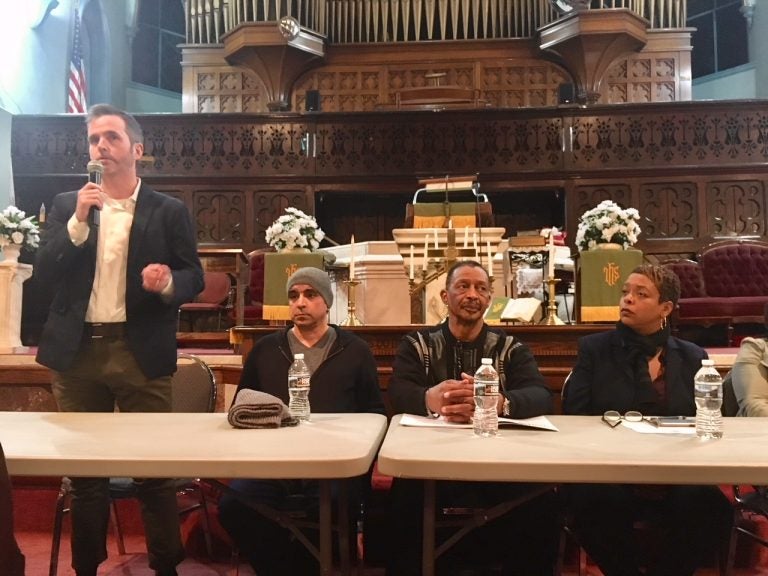
Philadelphia Inquirer columnist Mike Newall, far left, speaks at a community meeting about the prospect of the city hosting a safe-injection site. Seated next to him, left to right, are Gilberto Gonzales, Louis Cain, and City Councilwoman Cindy Bass. (Darryl Murphy/for WHYY)
Philadelphia moved a step closer to opening what could be the nation’s first safe-injection site when officials, including the mayor, gave the idea the green light last month. But a heated meeting on Friday night showed that turning any such idea into a reality will likely face community pushback.
“It’s a site where people can access care and also be in a safe environment where they’re using,” Roland Lamb, with the city’s department of behavioral health, told the packed Mt. Tabor AME Church near north 7th Street and Girard Avenue. “The issue for us is we’re looking to save lives.”
“We don’t need one of these sites in my neighborhood, I don’t,” said panelist and Kensington resident, Gilberto Gonzales.
Many in the audience of more than 200 people applauded as Gonzales said he worries about his middle school-aged son, and what he has to witness to and from school each day.
Would this become a draw for more drug users?
“They also need to protect the community, they need to protect my son,” Gonzales said.
Prompted by an estimated 1,200 overdose deaths last year, with the majority due to opioids, a city task force has been reviewing research on how safe-injection sites have worked in other countries, and what that could mean in Philadelphia. The group issued a report, which estimates such sites could prevent 24 to 76 deaths annually in Philadelphia, along with 1 to 18 cases of HIV and 15 to 213 cases of hepatitis C.
While this is uncharted territory in the U.S., proponents believe a place where people could inject their drugs under medical supervision could save lives, connect more people to treatment, and reduce open drug use in neighborhoods. The city’s district attorney has said he won’t prosecute people for using such a place, but it’s unclear what federal law enforcement might do. The city is now looking into supporting a site, if outside funders are willing to set it up as a private nonprofit.
Still, many who showed up to Friday night’s meeting were upset, having just heard about the idea for the first time. The decision also did not go through city council for approval. Those behind the idea say they didn’t need council’s blessing in order to move forward.
“I was horrified because what it says is you’re sanctifying using,” said Beverly Harris, of North Philadelphia, adding that she’d rather see the focus on improving resources for treatment. She’s in recovery herself, and is now struggling to find a program that will take her daughter.
Evan Figueroa-Vargas, also in recovery, was on the mayor’s opioid task force. He’s from Kensington and his son lives a few blocks from a former heroin encampment there. At first, Figueroa-Vargas said he was angry at the idea of a safe-injection site in the neighborhood, too, but he changed his mind after reading more about it.
“And I just want to mention this is not the solution. It is one of many tools being explored,” he said.
Others in the room wondered how drug dealers would be handled around any such site.
Still others, drawing attention to their own personal and family stories of addiction, spoke of unhealed wounds from a decades-long drug war that has destroyed communities of color, communities who see a new kind of attention being paid to the drug crisis now that more white people are dying.
“When this was considered, was anything considered to help people who were damaged during the crack era?” asked Solomon Jones. Jones, a blogger and commentator for WHYY and other Philadelphia media outlets, moderated and organized the event.
Panelists included City Councilwoman Cindy Bass, Councilman David Oh, Philadelphia Inquirer columnist Mike Newall, Quetcy Lozada with Councilwoman Maria Quinones-Sanchez’s office, Pastor Michael Couch, opioid task force member Devin Reaves, and addiction treatment provider Louis Cain.
Lamb, with the city, said he wasn’t surprised by the pushback and anger. He said he and others need to do a better job communicating about what’s going on and getting rid of the stigma surrounding drug addiction. And when it comes to opening a safe-injection site, Lamb said a lot has yet to be decided, in terms of when, where and how any such intervention would roll out.
“I think we need to do a more [better] job of telling people of what we’re doing,” he said. “The solution is in the community, the solution is not in me. I can’t make those decisions.
“We’ve stigmatized everything, the drugs and people that use the drugs,” he added. “How many people have to die before we do something else?”
Editor’s note: This story has been updated to reflect that the report issued estimated that sites could prevent 15 to 213 cases of hepatitis C, not HIV as previously written.
WHYY is your source for fact-based, in-depth journalism and information. As a nonprofit organization, we rely on financial support from readers like you. Please give today.


